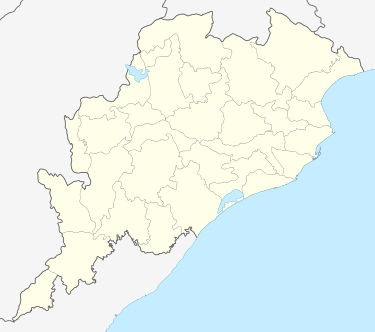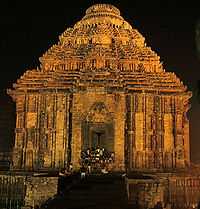Konark
| Konark କୋଣାର୍କ | |
|---|---|
| Town | |
|
Sun temple, Konark | |
 Konark Location in Odisha, India | |
| Coordinates: 19°54′N 86°07′E / 19.90°N 86.12°ECoordinates: 19°54′N 86°07′E / 19.90°N 86.12°E | |
| Country |
|
| State | Odisha |
| District | Puri |
| Elevation | 2 m (7 ft) |
| Population (2001) | |
| • Total | 15,015 |
| Languages | |
| • Official | Oriya |
| Time zone | IST (UTC+5:30) |
| Website | http://konark.nic.in |
Konark (Oriya: କୋଣାର୍କ) (Sanskrit: कोणार्क) is a small town in the Puri district in the state of Odisha, India. It lies on the coast by the Bay of Bengal, 65 kilometers from the capital of the state, Bhubaneswar.[1] It is the site of the 13th-century Sun Temple, also known as the Black Pagoda, built in black granite during the reign of Narasimhadeva-I. The temple is a World Heritage Site.[2] The temple is now mostly in ruins, and a collection of its sculptures is housed in the Sun Temple Museum, which is run by the Archaeological Survey of India.
Konark is also home to an annual dance festival called Konark Dance Festival, held every December, devoted to classical Indian dance forms, including the traditional classical dance of Odisha, Odissi.[3]
On 16 February 1980, Konark lay directly in the path of a total solar eclipse.[4][5][6]
Etymology
The name Konârka is derived from the Sanskrit word Kona (meaning angle) and word Arka (meaning sun) in reference to the temple which was dedicated to the Sun god Surya.[2]
The Sun Temple

The Sun Temple was built in the 13th century and designed as a gigantic chariot of the Sun God, Surya, with twelve pairs of ornamented wheels pulled by seven horses. Some of the wheels are 3 meters wide. Only six of the seven horse still stand today.[2] The temple fell into disuse after an envoy of Jahangir desecrated the temple in the early 17th century.[2]
The Sun temple belongs to the Kalingan school of Indian temple architecture. The alignment of the Sun Temple is along the East-West direction. The inner sanctum or vimana used to be surmounted by a tower or shikara but it was razed in the 19th century. The audience hall or jagamohana still stands and comprises majority of the ruins. The roof of the dance hall or natmandir has fallen off. It stands at the eastern end of the ruins on a raised platform.[2]
History
In 1559, Mukunda Gajapati came to throne in Cuttack. He aligned himself as an ally of Akbar and an enemy of the Sultan of Bengal, Sulaiman Khan Karrani. After a few battles, Odisha finally fell. The fall was also aided by the internal turmoil of the state. In 1568, the Konark temple was said damaged by the army of Kalapahad, a general of the Sultan.[7] Kalapahad is also said to be responsible for damages to several other temples during the conquest.
Demographics
As of 2011 India census,[8] Konark had a population of 16,779. Males constitute 8,654 (52%) of the population and females 8,125 (48%).As of 2001 Census Konark has an average literacy rate of 57%, lower than the national average of 59.5%: male literacy is 64%, and female literacy is 49%. In Konark, 14% of the population is under 6 years of age.
See also
Biranchinarayan Temple, Buguda, a similar sun temple in Odisha.
References
- ↑ "Konark, Official Website (Approach)".
- ↑ 2.0 2.1 2.2 2.3 2.4 "World Heritage List: Konark". UNESCO. Retrieved 25 October 2012.
- ↑ "25th Konark Dance & Music festival".
- ↑ "Solar Eclipse". New Scientist. 13 Aug 1981. Retrieved 25 October 2012.
- ↑ Kapoor, R. C. "SOME TOTAL SOLAR ECLIPSES OBSERVED FROM INDIA". Indian Institute of Astrophysics.
In that sense the Feb 16, 1980 eclipse was a great awakener post Independence that created an unprecedented excitement among persons from all walks of life. The path of totality fell over places in India such as Hubli, Raichur, Nalgonda and Konark etc.
- ↑ "What's wrong with the Sun?". New Scientist. Retrieved 25 October 2012.
- ↑ Patnaik, Durga Prasad (1989). Palm Leaf Etchings of Odisha. Abhinav Publications. p. 4. Retrieved 25 October 2012.
- ↑ "Census of India 2001: Data from the 2001 Census, including cities, villages and towns (Provisional)". Census Commission of India. Archived from the original on 2004-06-16. Retrieved 2008-11-01.
Further reading
- G.C. Chauley, Sun Temple of Konark: History and Preservation ISBN 978-81-86867-73-0
- Ranjan Kumar Singh, Surya: The God and His Abode ISBN 81-903561-7-8
External links
| Wikimedia Commons has media related to Konark. |
- Konark, World Heritage Site, UNESCO
- Konark (Official Site), Tourism Department, Government of Odisha
-
 Konark travel guide from Wikivoyage
Konark travel guide from Wikivoyage
| ||||||||||||||
